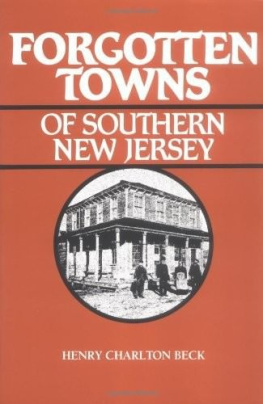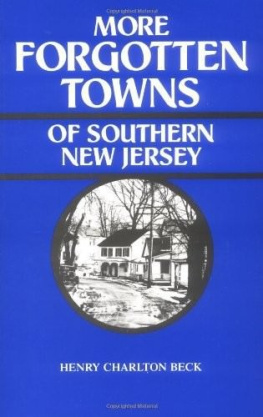




FORGOTTEN
TOWNS
of
SOUTHERN
NEW JERSEY
FOREWORD TO 1961 PRINTING
When Forgotten Towns of Southern New Jersey was published by E. P. Dutton and Company, of New York, in 1936, it was my hope to prepare another book on south Jersey, two on the midlands, and two on the upper end of the state. At least this was in my mind; and Merton S. Yewdale and Louise Townsend Nicholl, who were editors at Dutton's in those days, gave every encouragement to the project.
Admittedly I had little to recommend me apart from a young reporter's enthusiasm and three or four detective novels, but this first book and its successors, More Forgotten Towns and Fare to Midlands, which appeared in 1937 and 1939, fared comparatively well. I think this may have been because few people until then had considered that there could possibly be ghost towns in New Jersey. Or perhaps it was because of what the editors were kind enough to define as a combination of nostalgia, freshness of approach, and a certain naivete of discovery on the part of the chronicler.
Then came times of war, and when my schedule was resumed, I had become convinced that the story of the unsung Mullica River must be told-in the recollections and language of those who still lived in their ancestors' homes along its banks. So, in 1945, Jersey Genesis was born.
The manuscript of this book was rejected by a number of publishers, and finally, feeling that the story of the Mullica belonged to the state university, as well as to New Jersey itself, I sent it along to my old friend, Wallace S. Moreland, then assistant to the president of Rutgers University. The life of Jersey Genesis was meteoric, and it heartens me to know that it, too, may soon be reprinted. My most recent book, The Roads of Home, which tells the story of more of my journeyings, all over the state, was published in 1956 and is now in its third printing.
I must tell you that Forgotten Towns of Southern New Jersey is composed, for the most part, of sketches that were published weekly in the Courier-Post newspapers of Camden, New Jersey, of which I subsequently became State Editor. The sketches never were meant to be read as straight or even neat history, even in revised form. They were gleaned, in factual reporting, from the people and places whose stories I wanted to tell-and their basic validity is proved, I should think, by the loving confidence these people and places have continued to express. In all my books, as well as in the series of articles that I have been writing for the Newark Star-Ledger for over fifteen years, my concern has been with folklore rather than history as such. Thus, I have taken the best I could find and kept an open mind for change or variant. What you will find in this book is the story of what I actually found or saw and what was told to me by Jersey people, some twenty-five years ago.
Ong's Hat still has its identifying tree, but no Eli Freed. Batsto, ignored for so long, has become a state preserve, its curators intent on learning as much as they can about this important industrial center of Revolutionary times. Speedwell is now a turn in an improved road, with its slag pile all but obliterated. Some villages and hamlets of the past have been swallowed up by newcomers or erased by military establishments, or else they have simply faded away. About them all, by this time, there can be told new stories, different stories; but none would have emerged without the telling of the first. Today there are four different legends of how Ong's Hat, or Ong's Hut, got its name, and I have a notion that I may hear of at least one more.
At first I was dismayed at the idea of a reissue of Forgotten Towns because I knew that the people and places as I wrote of them in the early thirties could never be discovered that way again-I had midnight dreams of drivers all but wrecking their cars to find some thing or someone no longer there, of other travelers baffled and frustrated by new roads and people where once there were but swamps and sand trails and cedar water and silence. At last, persuaded more than ever that the people of New Jersey should become more keenly aware of all their heritage, not just around their homes but all over the state-in the mountains, in the flatlands, on the seacoast, and in the forest fastnesses-I have consented to this reissue. Dealers in old books may regret the appearance of this new printing, but the people who love New Jersey, for what it was, what it is, and what it will be, perhaps will not be disappointed. At least this is my hope.
HENRY CHARLTON BECK
Lawrenceville, New Jersey
June, ig61
FOREWORD
THE writing and revision of the stories which appear in this book represent the accurate chronicle of part of a most unusual and fascinating adventure. It began when the foreman of a newspaper composing-room, always ready with ideas for making busy people busier, proposed that an honest effort should be made to locate the town still indicated on maps of New Jersey by the mysterious name of Ong's Hat. It has gone on beyond Southern New Jersey and now, slowed down by the complexities of depression and recovery, as reflected in newspapers generally, it has paused for reflection and second wind.
Although Ong's Hat had been a name for the best part of a century, no one had ever taken it seriously, apparently. Once a managing editor had written some amusing stuff about it in his column on the editorial page. But the exactness of its location, just who lived in its domain and who were its ruling officials, if any, had remained unknown.
In consequence we set out next day-a State Editor and a photographer-in a car of uncertain functioning, determined to run Ong's Hat, and all relating to it, definitely to earth. The result of that first quest is the first sketch in this book. The history and modern status of Ong's Hat, however, failed to appease either the inquisitors' or the popular appetite, and the search for Forgotten Towns, thus informally begun, has become a "business" that is still going on.
A few of the stories which appeared in several series in the now defunct Sunday Courier-Post, the Evening Courier and the Morning Post of Camden, New Jersey, have been omitted because in comparison with the others selected here, they seemed somewhat drab of content. All of them, however, have brought a continued response from those who have read them, surprising even the author. Some letters he has received have found fault with unimportant detail but the majority have expressed keen interest and helpful appreciation of the quest. In this regard I would like to say that every effort has been made to make these narratives accurate and that at no time have they been colored by what is sometimes jocularly referred to as a newspaper imagination. A few critics, I am afraid, have based their contentions on the fact that the dull grist of history has been coated with a much more readable fancy; that, I contend, is something of an accomplishment.















